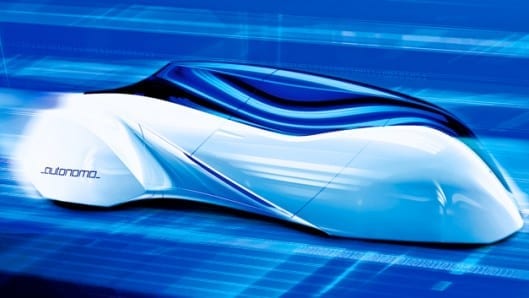Inspired by biomimicry, sustainability, artificial intelligence and information technology in general
Charles Rattray’s vision of what the automotive industry will be capable of by the year 2030 is far more feasible that it may seem at first glance. Autonomo, his fully autonomous vehicle concept, certainly looks the part, but should not be dismissed as just another flashy concept car. As car makers worldwide gear up to face the enormous challenges posed by congestion, pollution, and infrastructural deficiencies, Rattray’s final year student project offers a glimpse into the world where these challenges are already a thing of the past. Inspired by biomimicry, sustainability, artificial intelligence and information technology in general, the concept draws on technologies that are already being developed in R&D centers around the world.
Autonomous transport is central to the whole idea. Drawing heavily on the principles of swarm robotics, the self-driving autonomos travel in tight clusters that shift their configurations to maintain an uninterrupted flow of traffic while allowing particular vehicles to reach their respective destinations. This so called “platoon mode” allows to vastly reduce energy consumption through reducing the aerodynamic impact on the vehicles further back down the platoon. Thanks to microwave sensors, the spaces between vehicles are reduced to mere 20cm (7.8 inches), as keeping a safe distance from cars ahead is no longer required. Another type of microwave detectors scan the road surface ahead to prime the suspension accordingly and provide a smoother ride.
Needless to say, the whole operation is run by computers. Each drive-by-wire autonomo has an onboard computer that crunches the data received from an array of sensors (e.g. radar, microwave, lidar, optical and infrared sensors) as well as from external feedback systems. This enables monitoring the road 200m (656 feet) in front and behind the vehicle, or a whole platoon of vehicles, regardless of weather conditions. The cars understand their surroundings well enough to anticipate any changes in the road environment and react to them much quicker that even the most experienced humans. Even the acute senses of the homo sapiens are no match to a set of hi-definition cameras coupled with object recognition technologies capable of interpreting human gestures and predicting the path of other vehicles, cyclists, pedestrians or any other potentially hazardous objects.
This local level of awareness is augmented by data streamed from a constantly updated centralized database responsible for the real-time balancing of mobility demands across the entire network. Such a database would be controlled by intelligent algorithms that learn from the information that is fed to them. Historical data and the data collected in real time would be used to efficiently match the infrastructure real estate with the changing demands of ever fluctuating traffic.
Read more . . .
Bookmark this page for “autonomous vehicle” and check back regularly as these articles update on a very frequent basis. The view is set to “news”. Try clicking on “video” and “2” for more articles.








